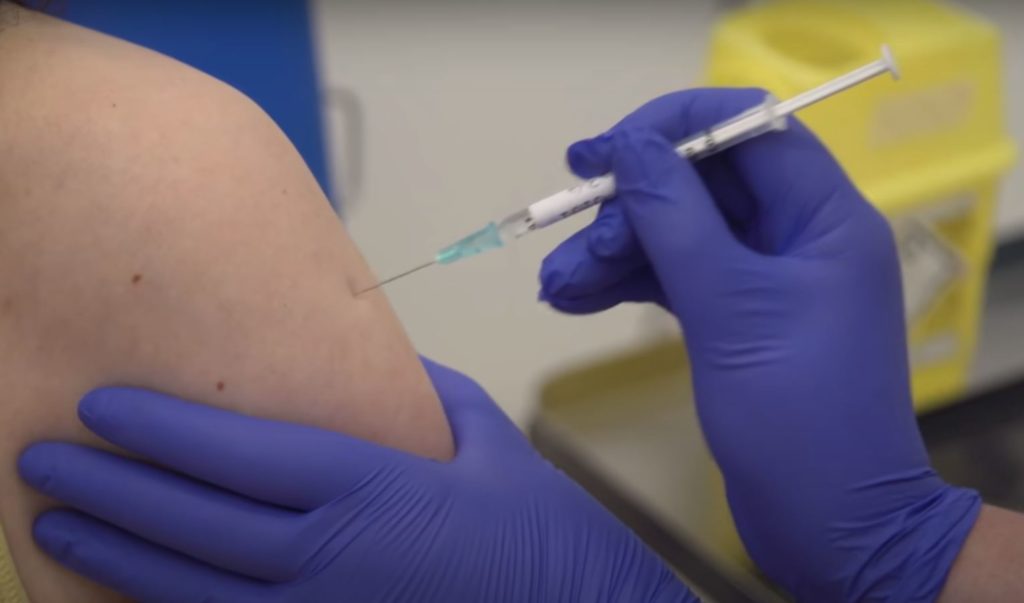University of Oxford researchers have begun recruiting for the next phase in human trials of a COVID-19 vaccine in human volunteers.

The phase I trial in healthy adult volunteers began in April. More than 1,000 immunisations have been completed and follow-up is currently ongoing.
The next study will enrol up to 10,260 adults and children and will involve a number of partner institutions across the country.
Learn more about the trial, including recruitment.
The phase II part of the study involves expanding the age range of people the vaccine is assessed in, to include a small number of older adults and children:
- Aged 56-69
- Aged over 70
- Aged between 5-12 years
For these groups, researchers will be assessing the immune response to the vaccine in people of different ages, to find out if there is variation in how well the immune system responds in older people or children.
The phase III part of the study involves assessing how the vaccine works in a large number of people over the age of 18. This group will assess how well the vaccine works to prevent people from becoming infected and unwell with COVID-19.
Adult participants in both the Phase II and Phase III groups will be randomised to receive one or two doses of either the ChAdOx1 nCoV-19 vaccine or a licensed vaccine (MenACWY) that will be used as a ‘control’ for comparison.
ChAdOx1 nCoV-19 is made from a virus (ChAdOx1), which is a weakened version of a common cold virus (adenovirus) that causes infections in chimpanzees, that has been genetically changed so that it is impossible for it to replicate in humans.
Three leading members of the Oxford BRC’s Vaccines Theme are leading the trial: Prof Sarah Gilbert and Prof Adrian Hill of the University of Oxford’s Jenner Institute and Prof Andrew Pollard of the University’s Oxford Vaccine Group.

Prof Pollard (left), head of the Oxford Vaccine Group, said: “The clinical studies are progressing very well and we are now initiating studies to evaluate how well the vaccine induces immune responses in older adults, and to test whether it can provide protection in the wider population. We are very grateful to the huge support of the trial volunteers in helping test whether this new vaccine could protect humans against the pandemic coronavirus.”
Prof Gilbert, professor of vaccinology at the Jenner Institute, said: “The COVID-19 vaccine trial team have been working hard on assessing the safety and immunogenicity of ChAdOx1 nCoV-19, and preparing to assess vaccine efficacy. We have had a lot of interest already from people over the age of 55 years who were not eligible to take part in the phase I study, and we will now be able to include older age groups to continue the vaccine assessment. We will also be including more study sites, in different parts of the country.”
The Oxford BRC provided crucial funding to get the trial up and running and then helped to fund an evaluation of the safety of the vaccine.
This study aims to assess how well people across a broad range of ages could be protected from COVID-19 with this new vaccine called ChAdOx1 nCoV-19. It will also provide valuable information on safety aspects of the vaccine and its ability to generate good immune responses against the virus.
The Oxford Vaccine Centre COVID-19 Phase II/III Clinical Trial Explained
What is the purpose of this research study?
The purpose of this study is to test a new vaccine against COVID-19 in healthy volunteers.
This study aims to assess how well people across a broad range of ages could be protected from COVID-19 with this new vaccine called ChAdOx1 nCoV-19. It will also provide valuable information on safety aspects of the vaccine and its ability to generate good immune responses against the virus.
What is the vaccine being tested?
ChAdOx1 nCoV-19 is made from a virus (ChAdOx1), which is a weakened version of a common cold virus (adenovirus) that causes infections in chimpanzees, that has been genetically changed so that it is impossible for it to grow in humans.
Genetic material has been added to the ChAdOx1 construct, that is used to make proteins from the COVID-19 virus (SARS-CoV-2) called Spike glycoprotein (S). This protein is usually found on the surface of SARS-CoV-2 and plays an essential role in the infection pathway of the SARS-CoV-2 virus. The SARS-CoV-2 coronavirus uses its spike protein to bind to ACE2 receptors on human cells to gain entry to the cells and cause an infection.
By vaccinating with ChAdOx1 nCoV-19, we are hoping to make the body recognise and develop an immune response to the Spike protein that will help stop the SARS-CoV-2 virus from entering human cells and therefore prevent infection.
Has the vaccine been tested on animals?
Our collaborators at Rocky Mountain Laboratories (NIAID/NIH) have conducted a rapid yet thorough investigation and demonstrated good safety and efficacy of a single dose of ChAdOx1 nCoV-19 in the rhesus macaque model that they had previously established. We were able to review the data before vaccinations in the clinical trial were initiated. There are also animal studies underway in Australia and the UK, and the results will be published once those studies are complete.
What does the study involve?
In total this study will enrol up to 10,260 adults and children across the UK.
The phase II part of the study involves expanding the age range of people the vaccine is assessed in, to include a small number of adults and children:
- Aged 56-69
- Aged over 70
- Aged between 5-12 years
For these groups, researchers are assessing the immune response to the vaccine in people of different ages, to find out if there is variation in how well the immune system responds in older people or children.
The phase III part of the study involves assessing how the vaccine works in a large number of people over the age of 18. This group will allow assessment of how well the vaccine works to prevent people from becoming infected with COVID-19.
Adult participants in both the Phase II and Phase III groups will be randomised to receive one or two doses of either the ChAdOx1 nCoV-19 vaccine or a licensed vaccine (MenACWY) that will be used as a ‘control’ for comparison.
What is the MenACWY vaccine?
The MenACWY vaccine is a licensed vaccine against group A, C, W and Y meningococcus which has been given routinely to teenagers in the UK since 2015 and protects against one of the most common causes of meningitis and sepsis. This vaccine is also given as a travel vaccine for high risk countries.
The MenACWY vaccine is being used as an ‘active control’ vaccine in this study, to help us understand participants’ response to ChAdOx1 nCoV-19. The reason for using this vaccine, rather than a saline control, is because we expect to see some minor side effects from the ChAdOx1 nCOV-19 vaccine such as a sore arm, headache and fever. Saline does not cause any of these side effects. If participants were to receive only this vaccine or a saline control, and went on to develop side effects, they would be aware that they had received the new vaccine. It is critical for this study that participants remain blinded to whether or not they have received the vaccine, as, if they knew, this could affect their health behaviour in the community following vaccination, and may lead to a bias in the results of the study.
Who can take part in the study?
| Participants must: | Participants must NOT: |
| Be in one of the relevant age categories | Have tested positive for COVID-19 |
| Be in good health | Be pregnant, intending to become pregnant, or breastfeeding during the study |
| Based in one of the recruiting areas | Have previously taken part in a trial with an adenoviral vaccine or received any other coronavirus vaccines |
Full inclusion and exclusion criteria is available in the participant information sheet.
How will the trial work?
The main focus of the study is to find out if this vaccine is going to work against COVID-19, if it won’t cause unacceptable side effects and if it induces good immune responses. The dose used in this trial was chosen based on previous experiences with other ChAdOx1 based vaccines.
Study participants will not know whether they have received the ChAdOx1 nCoV-19 vaccine until the end of the trial.
To recruit the large number of participants needed for this trial, multiple clinical research sites across the UK are involved in delivering the study. This is a collaborative effort led by the University of Oxford and a full list of our study sites is available on our website. Vaccinations will be taking place across the sites in May and June.
What about after the vaccination?
Some participants will be given an E-diary to record any symptoms experienced for 7 days after receiving the vaccine and if they feel unwell for the following 3 weeks. There is also a weekly survey that participants will be asked to complete about any household exposure to COVID-19.
In order to monitor exposure to COVID-19 in people who do not have symptoms, participants in some areas will be asked to collect swabs at home to be sent to the laboratory for testing.
Following vaccination, participants will attend a series of short follow-up visits. During these visits, the team will check participants’ observations, take a blood sample and review the completed E-diary and questionnaire. These blood samples will be used to assess the immune response to the vaccine.
If participants develop COVID-19 symptoms during the study, they can contact a member of the clinical team, and we will assess them to check whether they have become infected with the virus. If a participant was very unwell, we would call our colleagues in the hospital and ask them to review the volunteer if appropriate.
When will the results be available?
To assess whether the vaccine works to protect from COVID-19, the statisticians in our team will compare the number of infections in the control group with the number of infections in the vaccinated group. For this purpose, it is necessary for a small number of study participants to develop COVID-19. How quickly we reach the numbers required will depend on the levels of virus transmission in the community. If transmission remains high, we may get enough data in a couple of months to see if the vaccine works, but if transmission levels drop, this could take up to 6 months. Recruitment of those who have a higher chance of being exposed to the SARS-CoV-2 virus is being prioritised, such as frontline healthcare workers, frontline support staff and public-facing key workers, in an effort to capture the efficacy data as quickly as possible.
What if it doesn’t work?
A significant proportion of vaccines that are tested in clinical trials don’t work. If we are unable to show that the vaccine is protective against the virus, we would review progress, examine alternative approaches, such as using different numbers of doses, and would potentially stop the programme.